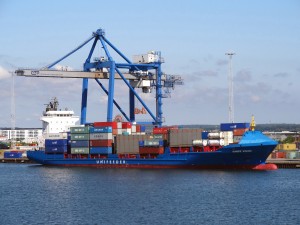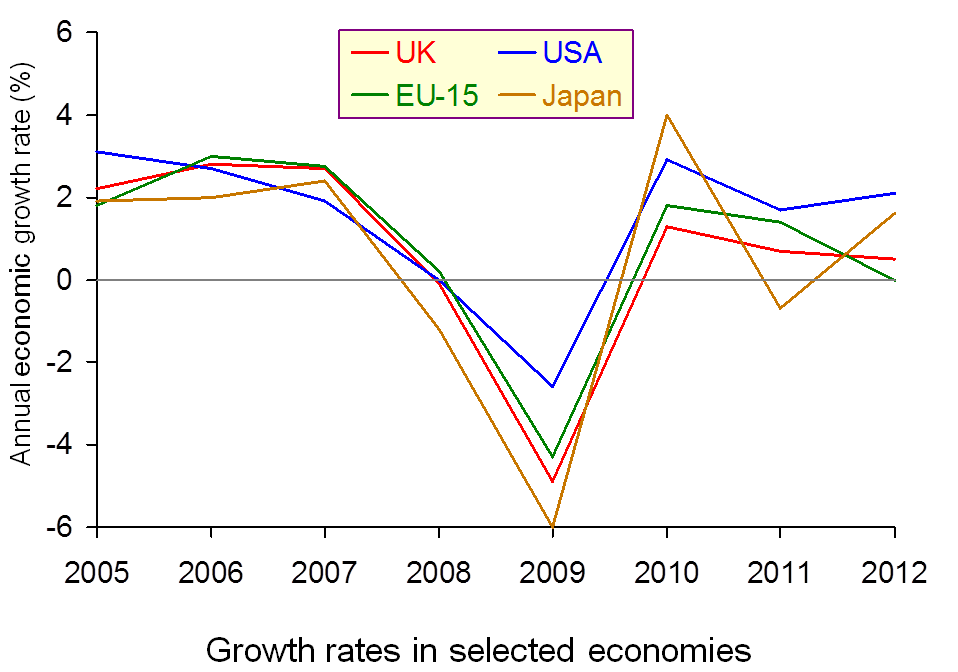 Australia was one of the few economies that seemed to be somewhat insulated from the 2008/09 recession and credit crunch. However, with the UK now back in recession and global economic conditions worsening in much of Europe, Australia has now joined the list of countries that are experiencing economic conditions that are ‘weaker than forecast’.
Australia was one of the few economies that seemed to be somewhat insulated from the 2008/09 recession and credit crunch. However, with the UK now back in recession and global economic conditions worsening in much of Europe, Australia has now joined the list of countries that are experiencing economic conditions that are ‘weaker than forecast’.
Today’s world involves economies that are increasingly interdependent, hence the spread of the world economic slowdown. As such, with weak global demand, Australia has started to feel the effects, with demand for its goods and raw materials falling. This has led Australia’s central bank – the Reserve Bank of Australia – to cut its key interest rate (the ‘cash rate’) by more than expected. The rate had been at 4.25% and it was widely believed that a 0.25 percentage point cut would occur. However, the central bank cut the cash rate rate to 3.75% to counter the weakening conditions. The Reserve Bank said:
“This decision is based on information received over the past few months that suggests that economic conditions have been somewhat weaker than expected, while inflation has moderated …Growth in the world economy slowed in the second half of 2011, and is likely to continue at a below-trend pace this year.”
Banks’ interest rates have been falling in Australia for the past few months and this latest cut will do much to help financially squeezed households. Data show that Australian house sales have fallen, as have house prices, and retail sales have fared little better.
Lower interest rates are often a tool used to steer inflation and the Australian central bank may not have been as willing to cut rates had the inflation rate not come down in recent months. Keeping consumer prices under control remains a top priority for the central bank and so it will be interesting to see the impact that these rate cuts will have on the Australian economy.
Articles
Australia cenbank surprises with aggressive half point rate cut Reuters, Wayne Cole (1/5/12)
Australia cuts rates by than forecast to 3.75% BBC News (1/5/12)
Banks unlikely to pass on full rate cut The Australian, Wall Street Journal, Peter Trute (1/5/12)
Australia cuts rate to support economy Financial Times, Neil Hume (1/5/12)
Australia slashes interest rates by 0.5pc to boost economy The Telegraph (1/5/12)
Australia cuts interest rates as economy slows Guardian, Phillip Inman (1/5/12)
Banks must pass on rate cut: businesses Sydney Morning Herald, Ehssan Veiszadeh (1/5/12)
Bond prices rally after rate cut Sydney Morning Herald (1/5/12)
Surplus remains appropriate: Swan Sydney Morning Herald, Colin Brinsden (1/5/12)
Webcasts
 Reserve Bank of Australia Cuts Rates by 50 Basis Points to 3.75% CNBC video, Lauren Rosborough (1/5/12)
Reserve Bank of Australia Cuts Rates by 50 Basis Points to 3.75% CNBC video, Lauren Rosborough (1/5/12)
 Further `Modest’ RBA Easing Possible, ANZ Says Bloomberg, Tony Morriss (1/5/12)
Further `Modest’ RBA Easing Possible, ANZ Says Bloomberg, Tony Morriss (1/5/12)
 Australia’s central bank shifts focus to growth BBC News, Duncan Kennedy (1/5/12)
Australia’s central bank shifts focus to growth BBC News, Duncan Kennedy (1/5/12)
Questions
- Which factors will a central bank consider when setting interest rates?
- Explain the components of aggregate demand that will be affected by a lower rate of interest.
- Using diagrams to illustrate the process, explain both the interest-rate and the exchange-rate transmission mechanisms of the fall in interest rates.
- How are interest rates used to target inflation?
- How will lower rates of interest help the Australian economy recover from weakening global economic conditions?
- Why are Australia’s banks unlikely to pass on the full rate cut to consumers?
- Why did bond prices rise and the Australian dollar depreciate after the rate cut? Why does this suggest that a 0.5% cut was greater than anticpated by markets?
 The UK is officially back in recession: or to be more accurate, a double-dip recession.
The UK is officially back in recession: or to be more accurate, a double-dip recession.
The generally accepted definition of a recession is two or more quarters of negative growth in real GDP. According to figures released by the Office for National Statistics, the UK economy shrank by 0.2% in quarter 1, 2012, having shrunk by 0.3% in quarter 4, 2011.
(Click on the following link for a PowerPoint of the above chart: Double dip 2)
As you can see from the chart (click chart for a larger version), these declines are tiny compared with the recession of 2008/9. Nevertheless, with the eurozone economy slowing (Britain’s largest export market), and with cuts to government expenditure set to bite harder in the coming months, there are worries that there may be more quarters of negative growth to come.
So what are the causes of this double-dip recession? Are they largely external, in terms of flagging export markets; or are they internal? Is the new recession the direct result of the tight fiscal policy pursued by the Coalition government?
And what is to be done? Is there no option but to continue with the present policy – the government’s line? Or should the austerity measures be reined in? After all, as we saw in the last blog post (Economic stimulus, ‘oui’; austerity, ‘non’), the mood in many European countries is turning against austerity.
The following articles explore the causes and policy implications of the latest piece of bad news on the UK economy.
Articles
Double-dip recession a terrible blow for George Osborne Guardian, Larry Elliott (25/4/12)
Double-dip recession figures mark another bad day for George Osborne Guardian, Larry Elliott (25/4/12)
UK double-dip recession: what the economists say Guardian (25/4/12)
Feared double dip recession becomes reality as British economy contracts again in first quarter of 2012 Daily Record (25/4/12)
Britain in double-dip recession as growth falls 0.2pc The Telegraph, Angela Monaghan and Szu Ping Chan (25/4/12)
Did the eurozone crisis cause the double-dip recession? Guardian, Polly Curtis (25/4/12)
UK’s double-dip recession Financial Times, Chris Giles (25/4/12)
UK is in ‘double dip’ recession FT Adviser, Rebecca Clancy and John Kenchington (25/4/12)
 Flanders explains GDP figure BBC News, Stephanie Flanders (25/4/12)
Flanders explains GDP figure BBC News, Stephanie Flanders (25/4/12)
No recovery for UK: No let up for ONS BBC News, Stephanie Flanders (25/4/12)
Double-dip recession: There’s always fantasy island BBC News, Paul Mason (25/4/12)
UK double-dip recession to drag on into summer, economists warn The Telegraph, Philip Aldrick (26/4/12)
George Osborne can stop the rot, but only by spending as he slashes The Telegraph, Jeremy Warner (25/4/12)
Double dip has arrived – and Osborne is running out of escape routes Independent, Ben Chu (26/4/12)
Britain’s bosses tell the ONS: it’s bad, but not a recession Independent, Tom Bawden, Lucy Tobin , Gideon Spanier (26/4/12)
The Chancellor received plenty of warning Independent, David Blanchflower (26/5/12)
Data
Gross Domestic Product: Preliminary Estimate, Q1 2012 ONS (25/4/12)
Preliminary Estimate of GDP Time Series Dataset 2012 Q ONS (25/4/12)
World Economic Outlook Database IMF (17/4/12)
Business and Consumer Surveys (for all individual EU countries and for the EU as a whole) European Commission: Economic and Financial Affairs
Consumer Confidence Nationwide Building Society
Questions
- Assess the current state of the UK economy and its likely course over the coming few months.
- Why may looking at the business surveys provide a truer picture of the state of the UK economy than the official measure of GDP?
- Why has the UK economy gone back into recession?
- Compare the policy approaches of the Coalition government with those of the Labour opposition.
- How important is it for the UK to retain its AAA credit rating?
 A crucial determinant of the economy’s short-term prospects is the appetite of households for spending. This is because household spending makes up roughly two-thirds of the total demand for firms’ goods and services or two-thirds of what economists refer to as aggregate demand. So what are the latest forecasts for consumer spending? We briefly consider the forecasts of the Office for Budget Responsibility for consumer spending and, in doing so, update an earlier bog Gloomy prospects for spending in 2012?
A crucial determinant of the economy’s short-term prospects is the appetite of households for spending. This is because household spending makes up roughly two-thirds of the total demand for firms’ goods and services or two-thirds of what economists refer to as aggregate demand. So what are the latest forecasts for consumer spending? We briefly consider the forecasts of the Office for Budget Responsibility for consumer spending and, in doing so, update an earlier bog Gloomy prospects for spending in 2012?
In its March 2012 Economic and Fiscal Outlook the Office for Budget Responsibility presents it forecasts for economic growth and household spending. The following table summarises these forecasts.
OBR Forecasts (annual real percentage change)
|
2012 |
2013 |
2014 |
2015 |
2016 |
| GDP |
0.8 |
2.0 |
2.7 |
3.0 |
3.0 |
| Consumption |
0.5 |
1.3 |
2.3 |
3.0 |
3.0 |
| Disposable income |
–0.2 |
0.5 |
1.9 |
2.4 |
2.5 |
 Australia was one of the few economies that seemed to be somewhat insulated from the 2008/09 recession and credit crunch. However, with the UK now back in recession and global economic conditions worsening in much of Europe, Australia has now joined the list of countries that are experiencing economic conditions that are ‘weaker than forecast’.
Australia was one of the few economies that seemed to be somewhat insulated from the 2008/09 recession and credit crunch. However, with the UK now back in recession and global economic conditions worsening in much of Europe, Australia has now joined the list of countries that are experiencing economic conditions that are ‘weaker than forecast’. Reserve Bank of Australia Cuts Rates by 50 Basis Points to 3.75% CNBC video, Lauren Rosborough (1/5/12)
Reserve Bank of Australia Cuts Rates by 50 Basis Points to 3.75% CNBC video, Lauren Rosborough (1/5/12) Further `Modest’ RBA Easing Possible, ANZ Says Bloomberg, Tony Morriss (1/5/12)
Further `Modest’ RBA Easing Possible, ANZ Says Bloomberg, Tony Morriss (1/5/12) Australia’s central bank shifts focus to growth BBC News, Duncan Kennedy (1/5/12)
Australia’s central bank shifts focus to growth BBC News, Duncan Kennedy (1/5/12)


